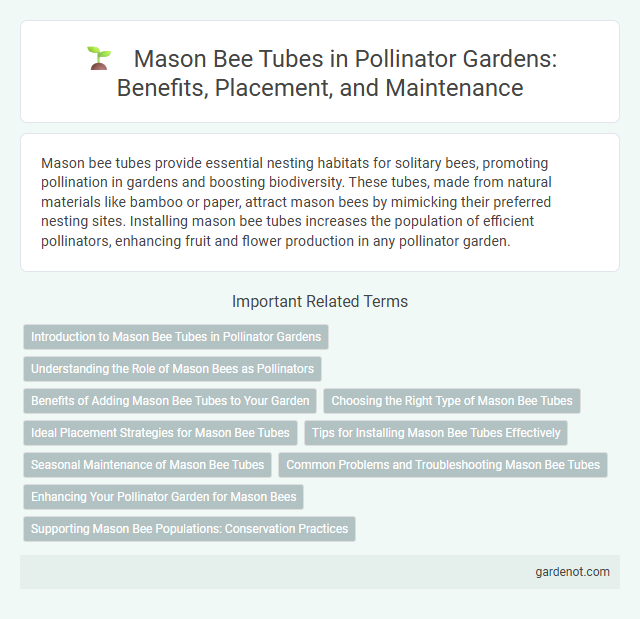Mason bee tubes provide essential nesting habitats for solitary bees, promoting pollination in gardens and boosting biodiversity. These tubes, made from natural materials like bamboo or paper, attract mason bees by mimicking their preferred nesting sites. Installing mason bee tubes increases the population of efficient pollinators, enhancing fruit and flower production in any pollinator garden.
Introduction to Mason Bee Tubes in Pollinator Gardens
Mason bee tubes provide essential nesting habitats for solitary mason bees, which are efficient pollinators in pollinator gardens. These tubes are typically made from natural materials like bamboo or paper and feature multiple small tunnels where female mason bees lay their eggs. Incorporating mason bee tubes supports biodiversity and increases pollination rates for fruit trees, flowers, and vegetables in sustainable garden ecosystems.
Understanding the Role of Mason Bees as Pollinators
Mason bees play a crucial role in pollination by efficiently transferring pollen between flowers, resulting in higher fruit and seed production compared to honeybees. These solitary bees use mason bee tubes as nesting sites, which provide safe environments for their larvae and support population growth. Incorporating mason bee tubes into pollinator gardens enhances biodiversity and strengthens local ecosystems by boosting pollination services for various plants.
Benefits of Adding Mason Bee Tubes to Your Garden
Mason bee tubes provide essential nesting habitats that increase pollination rates by attracting solitary bees, leading to enhanced fruit and vegetable yields. These tubes support the lifecycle of mason bees, which are efficient, non-aggressive pollinators that thrive in urban and suburban gardens. Incorporating mason bee tubes promotes biodiversity, reduces the need for chemical pollinators, and fosters a healthier garden ecosystem.
Choosing the Right Type of Mason Bee Tubes
Selecting the right type of Mason bee tubes involves considering materials such as paper, bamboo, or wood, each offering varying durability and habitat suitability. Tubes with diameters ranging from 6 to 8 millimeters best accommodate Mason bee species like Osmia lignaria, promoting efficient nesting and pollination. Opting for removable, washable tubes enhances long-term garden health by preventing parasite buildup and facilitating yearly maintenance.
Ideal Placement Strategies for Mason Bee Tubes
Mason bee tubes perform best when placed in a sunny, sheltered location facing southeast to capture early morning warmth. Positioning the tubes at least 3 to 6 feet above ground reduces predator risks and maintains stability. Ensuring the tubes are mounted on a vibration-free surface near diverse flowering plants enhances pollination efficiency and bee activity.
Tips for Installing Mason Bee Tubes Effectively
Select a sheltered location with partial sunlight and avoid areas exposed to heavy rain or strong winds to protect mason bee tubes. Mount the tubes securely at a height of 3 to 6 feet, facing southeast or east for optimal morning warmth. Ensure the tubes are clean, dry, and replaced annually to prevent disease and encourage healthy mason bee populations.
Seasonal Maintenance of Mason Bee Tubes
Seasonal maintenance of Mason bee tubes involves cleaning and disinfecting the tubes after the active pollination period to prevent parasite buildup and disease. Old nesting materials should be removed in late fall or early winter to reduce risk of mold and fungal growth, ensuring healthier conditions for emerging bees in spring. Proper storage of tubes in a cool, dry place during winter preserves the integrity of the larvae and supports successful bee populations in the pollinator garden.
Common Problems and Troubleshooting Mason Bee Tubes
Mason bee tubes often face issues such as mold growth, parasitic wasp infestations, and tube clogging from mud or debris, which can hinder bee development. Ensuring proper ventilation, regularly cleaning or replacing tubes, and positioning them away from excessive moisture or direct sunlight can mitigate these problems. Monitoring for signs of pests and maintaining a dry environment are critical steps to support a healthy mason bee population.
Enhancing Your Pollinator Garden for Mason Bees
Mason bee tubes provide essential nesting habitats that attract solitary mason bees, significantly boosting pollination efficiency in your garden. Made from natural materials like bamboo or wood, these tubes mimic the bees' preferred environment, encouraging nesting and reproduction. Strategically placing mason bee tubes near flowering plants enhances fruit and vegetable yields by supporting healthy pollinator populations.
Supporting Mason Bee Populations: Conservation Practices
Mason bee tubes provide essential nesting habitats that support the reproduction and survival of native mason bee populations, crucial pollinators for many plants. Implementing conservation practices such as regularly cleaning and replacing tubes prevents disease and parasitic infestations, enhancing population health. Strategic placement of these tubes in diverse, pesticide-free pollinator gardens ensures successful mating and foraging activities, contributing to ecosystem stability.
Mason bee tube Infographic

 gardenot.com
gardenot.com